Mochi: 10 Tasty Variations of Glutinous Rice Confections

Our guide to Japan's mochi confections explains what is mochi rice and introduces 10 types of traditional Japanese sweets that use mochi, including sakura mochi, warabi mochi, and daifuku. We also mention the precautions needed when eating these tasty glutinous rice confections
Mochi: Japan's Tasty Glutinous Rice Confections
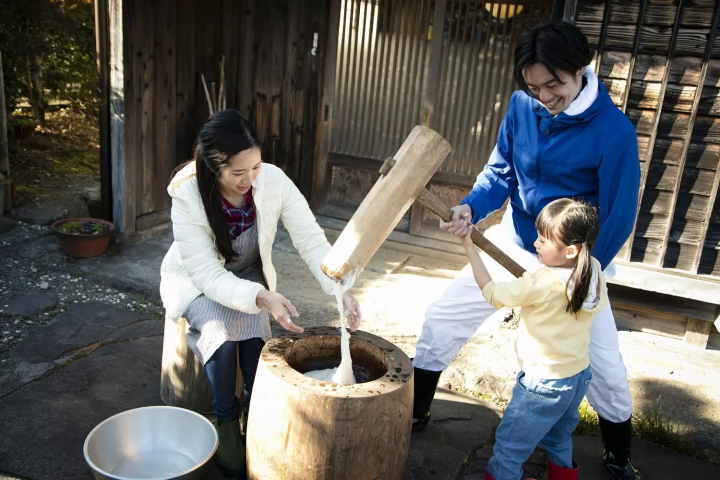
Mochitsuki (rice pounding) experience. Photo by Pixta
Mochi is a traditional type of Japanese confectionery made by steaming and pounding glutinous rice (mochigome). Unlike regular rice, cooked glutinous rice has a unique stickiness.
Mochi has long been indispensable to Japanese culture, especially during New Year celebrations and other festive events. The shape and flavors of mochi can vary widely by region and household.
Read on to learn 10 traditional Japanese mochi confections and famous shops where you can taste them. We've also included important points to consider when consuming glutinous rice confections.
Traditional Mochi Confections
1. Sakura Mochi
2. Warabi Mochi
3. Daifuku
4. Kashiwa Mochi
5. Yomogi Mochi
6. Kagami Mochi
7. Kurumi Mochi
8. Ohagi
9. Suama
10. Shiruko
Choking Hazard: Precautions When Eating Mochi
1. Sakura Mochi
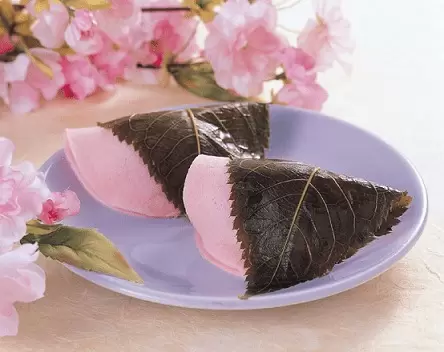
Chomeiji Sakura Mochi. Photo by Pixta
Sakura mochi is a traditional Japanese sweet that heralds the arrival of spring. It is especially cherished as a staple during Hina Matsuri (Doll Festival) on March 3rd.
There are two main types of sakura mochi confections in eastern and western Japan, each with distinct characteristics.
In eastern Japan (Kanto), Chomeiji sakura mochi is the most common type. It features a crepe-like batter wrapped around sweet red bean paste and then enveloped in a salted sakura (cherry blossom) leaf.
Although it does not use glutinous rice as an ingredient, it is traditionally called sakura mochi.

Domyoji sakura mochi. Photo by Pixta
In contrast, Domyoji sakura mochi is the mainstream variety in western Japan (Kansai). It uses Domyoji flour made from steamed and dried glutinous rice to encase the sweet bean paste, which is also wrapped in a salted sakura leaf.
The distinct feature of sakura mochi is its fragrant rice wrapped in a sakura leaf, with the salted leaf enhancing its flavor and sweetness. This aroma evokes the feeling of spring's arrival, making sakura mochi a special treat to enjoy during the changing seasons.
A recommended place to try the Kanto-style sakura mochi is Chomeiji Sakuramochi in Sumida Ward, Tokyo. This long-established shop boasts over 300 years of history and is known for creating delicious Kanto-style sakura mochi.
Chomeiji Sakuramochi
Address: Tokyo, Sumida, Mukojima 5-1-14
Business Hours: 8:30 AM - 6:00 PM
Closed: Mondays and Tuesdays
Official Website: https://sakura-mochi.com/
2. Warabi Mochi
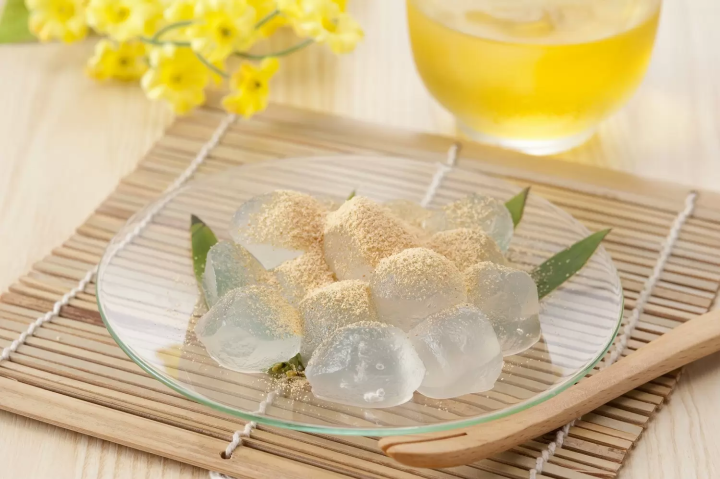
Photo by Pixta
Warabi mochi is a traditional Japanese dessert made from starch derived from bracken fern roots. It is especially popular in the summer.
Its transparent appearance and chewy texture are characteristic features while typically enjoyed with kinako (roasted soybean flour) and kuromitsu (black syrup) drizzled on top.
Creative variations, such as incorporating warabi mochi into drinks, have emerged, allowing for a wider range of enjoyment.
One highly recommended place to try warabi mochi is Matsukazean Kanesue in Kagawa. It is famous for using "honwarabi powder" without any mixed starch.
The texture and the harmony with kinako are exquisite, making it loved by many. What sets this shop's warabi mochi apart is its commitment to traditional methods while catering to modern tastes.
Matsukazean Kanesue
Address: Kagawa, Takamatsu, Ouginacho 1-24-36
Business Hours: 8:00 AM - 7:00 PM
Closed: January 1
Official Website: https://www.kanesue.net/shop/ (Japanese)
↑ Return to the top of article.
3. Daifuku
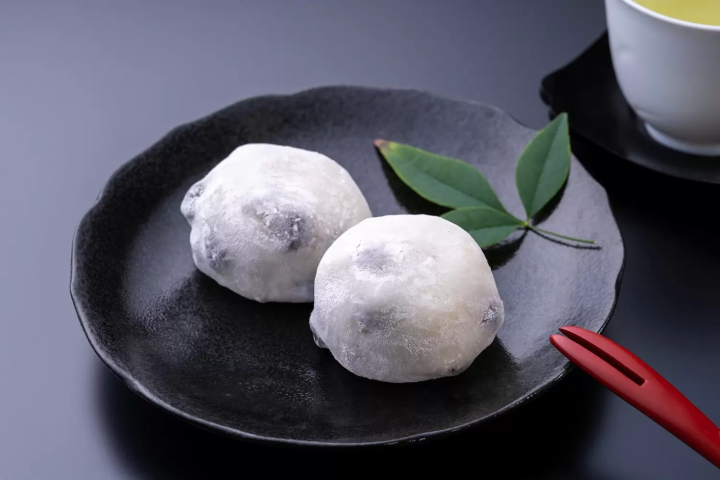
Photo by Pixta
Daifuku is a traditional Japanese confection made of mochi (glutinous rice) enveloping sweet bean paste. It is characterized by its simplicity yet rich flavor.
This dessert became popular among the commoners during the Edo period (1603-1868) and has spread as a staple for celebrations and special occasions.
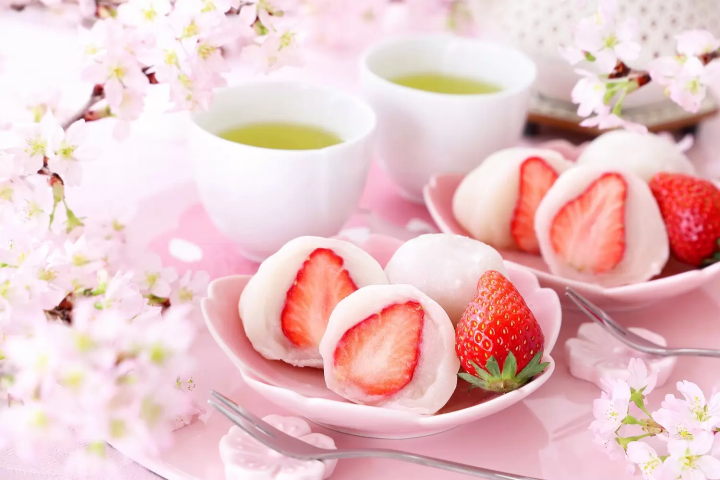
Strawberry daifuku. Photo by Pixta
Today, various adaptations exist, such as strawberry daifuku, which contains strawberries, and kusa daifuku, which incorporates yomogi (mugwort) into the mochi.
The charm of daifuku lies in the exquisite balance between sweetness and the softness of the mochi. The chewy texture combined with the sweetness of the bean paste creates a delightful explosion of flavors in your mouth.
A recommended stop is Honke Mamedaifuku Darumado, a longstanding wagashi shop in Gifu. It is famed for its award-winning mame daifuku (bean rice cake), which received the Prime Minister's Prize.
The shop offers a variety of daifuku, including mame daifuku, kusa daifuku, ume daifuku (plum), and kuri daifuku (chestnut). The popular mame daifuku features a soft yet elastic mochi skin, lightly salted black beans, and a subtly sweet bean paste, creating a perfect balance.
Honke Mamedaifuku Darumado
Address: 17 Naka Higashi-Cho, Kakamigahara City, Gifu Prefecture
Business Hours: 8:30 AM - 7:00 PM
Closed: Tuesdays
Official Website: http://www.mamedaifuku.jp/ (Japanese)
4. Kashiwa Mochi
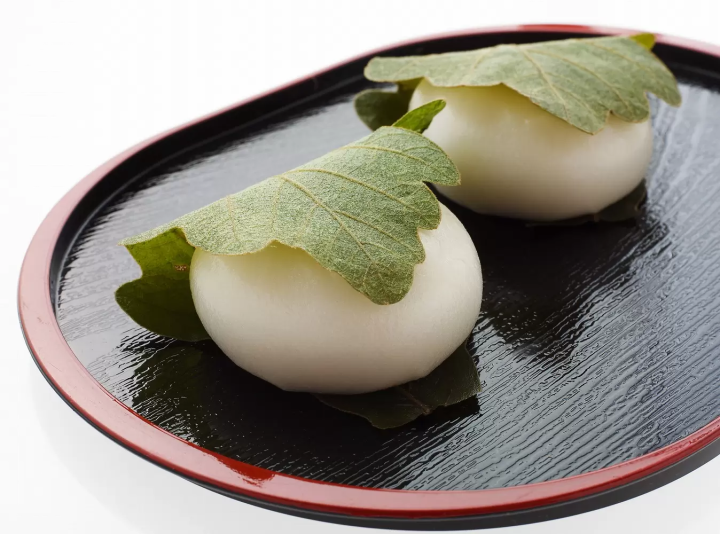
Photo by Pixta
Kashiwa mochi is a traditional Japanese sweet often eaten during Children's Day on May 5th. It consists of a flat, round mochi filled with sweet bean paste, folded in half, and wrapped in a kashiwa (oak) leaf.
The kashiwa leaf is significant because it does not drop its old leaves until new buds emerge, symbolizing prosperity for future generations.
Please note, however, that the kashiwa leaf is not edible. In contrast to the sakura leaf used in sakura mochi, which is pickled and soft, the oak leaf used in kashiwa mochi is uncooked, dry, and hard.
The kashiwa leaf gives the mochi a special fragrance, but it should be discarded when eating the confection.
The mochi is typically filled with smooth red bean paste (koshi-an) or miso paste. In some regions, you may find variations using chunky red bean paste (tsubuan) or white miso paste.
A highly recommended place to try kashiwa mochi is Kihei, a long-established shop loved by locals in Niigata.
You can enjoy the delightful combination of fragrant kashiwa leaves and smooth mochi skin.
Kihei
Address: 2-13-18 Sakai-higashi, Nishi, Niigata City, Niigata Prefecture
Business Hours: 9:30 AM - 6:00 PM
Closed: Mondays (the following day if it falls on a public holiday)
Official Website: http://www.kihei.co.jp/ (Japanese)
↑ Return to the top of article.
5. Yomogi Mochi

Photo by Pixta
Yomogi mochi is a type of mochi that incorporates yomogi (mugwort) and is also known as kusa mochi (grass mochi).
Characterized by its refreshing aroma and flavor of yomogi, it is particularly enjoyed in the spring. This traditional sweet has long been cherished for its health benefits.
The scent of yomogi evokes the arrival of spring and has historical significance. It was consumed during the Hina Matsuri (Doll Festival) on March 3rd.
Yomogi is a perennial herb from the Asteraceae family that is used as food and for medicinal purposes.
Chujodo Honpo, a renowned shop in Nara Prefecture, is a highly recommended place to enjoy yomogi mochi. The mochi made from homegrown yomogi is fragrant, pairing perfectly with the light sweetness of smooth red bean paste.
Chujodo Honpo
Address: 55-1 Taimayama, Katsuragi City, Nara Prefecture
Business Hours: 9:00 AM - 5:00 PM (until sold out)
Closed: All of July, mid-August through August 31, and late December through early January
Official Website: https://www.chujodo.com/ (Japanese)
6. Kagami Mochi
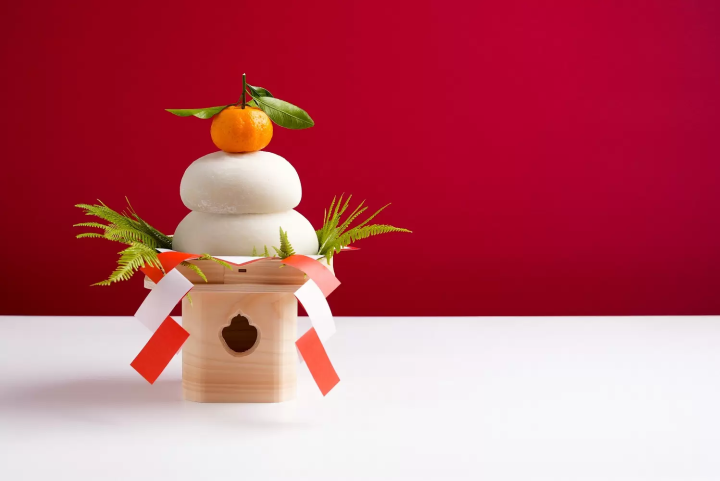
Photo by Pixta
Kagami mochi is a type of mochi offered during the New Year celebrations as a token of welcome to the Toshigami (New Year’s deity).
Its round shape symbolizes the spirit and is typically stacked in two layers of different sizes.
Kagami mochi is believed to serve as a vessel for the Toshigami, bringing happiness and blessings for the new year.
On the day of the kagami biraki (opening kagami mochi), families share and eat mochi to wish for good health and prosperity. The decorated kagami mochi is taken down, boiled, and consumed to pray for health and peace.
Typically, kagami mochi is displayed from December 28 until the end of the Matsunouchi period (up to January 7 or 15).
Kagami mochi is often adorned with auspicious symbols such as daidai (Japanese bitter orange), konbu (seaweed), and yuzu leaves, each carrying wishes for a happy new year.
A highly recommended choice is the kagami mochi from Rijomochi in Hiroshima Prefecture, made using traditional methods. It is famous for its beautiful shape and fragrant taste, making it a favorable decoration for the new year.
Rijomochi
Address: 1-24-17 Yawata, Saeki-ku, Hiroshima City (Sunribu Itsukaichi Store)
Business Hours: 10:00 AM - 9:00 PM
Closed: Irregular holidays
Official Website: http://www.omoti-r.com/ (Japanese)
Read also
↑ Return to the top of article.
7. Kurumi Mochi
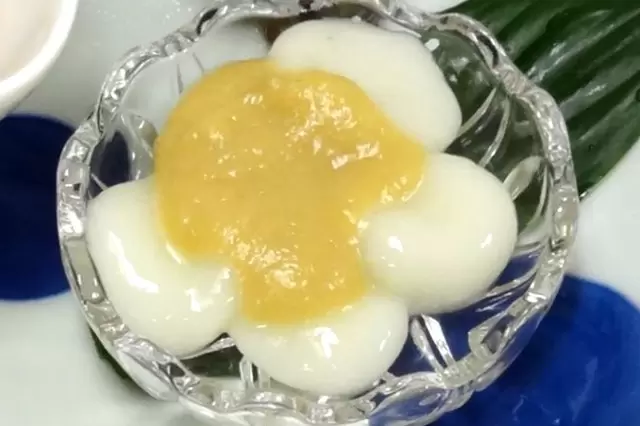
Kurumi mochi. Picture courtesy of the Ministry of Agriculture, Forestry and Fisheries website. Photo from Osaka's Local Cuisine: Inheritance of Festive Foods and Food Culture (Public Interest Incorporated Foundation Osaka Prefectural School Lunch Association)
Kurumi mochi is a traditional confection from Sakai City in Osaka Prefecture. Its history dates back to the Kamakura period (1185-1333).
The name comes from the mochi being wrapped ("kurumu") in a pale green bean paste. The filling is typically made from ingredients like blue soybeans, giving it a unique flavor and color.
Kurumi mochi is deeply connected to the tea culture of Sakai City, the birthplace of the famous tea master Sen no Rikyu. It has long been enjoyed as a sweet that pairs deliciously with tea.
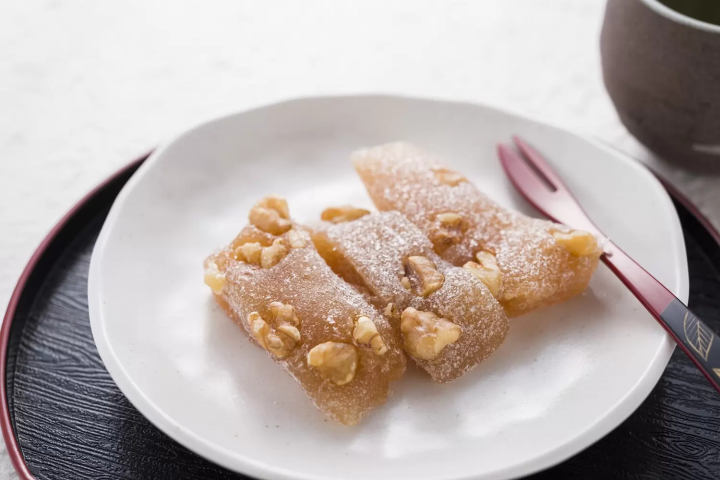
Kurumi yubeshi. Photo by Pixta
Please note that this confection is different from kurumi yubeshi, which is a specialty from the Tohoku region (northeastern Japan).
Kurumi yubeshi is also a type of mochi confectionery made from sugar, glutinous rice flour, and walnuts ("kurumi" in japanese). It is a sweet treat that features a delightful balance of sweetness and nuttiness.
A highly recommended spot to try kurumi mochi is Kanbukuro in Sakai City. This renowned shop is considered the origin of this sweet and attracts long lines on weekends. The appealing balance of the chewy mochi and the creamy bean paste is a highlight of this confection.
In the summer, they offer Kakigori Kurumi Mochi, which is Kurumi mochi topped with shaved ice. This is a favorite treat among those seeking relief from the heat.
Kanbukuro
Address: 1-2-1 Shinzaike-cho Higashi, Sakai-ku, Sakai City, Osaka Prefecture
Business Hours: 10:00 AM - 5:00 PM (last orders for dining in by 4:45 PM)
Closed: Tuesdays and Wednesdays (open on national holidays)
Official Website: https://kanbukuro.co.jp/ (Japanese)
8. Ohagi
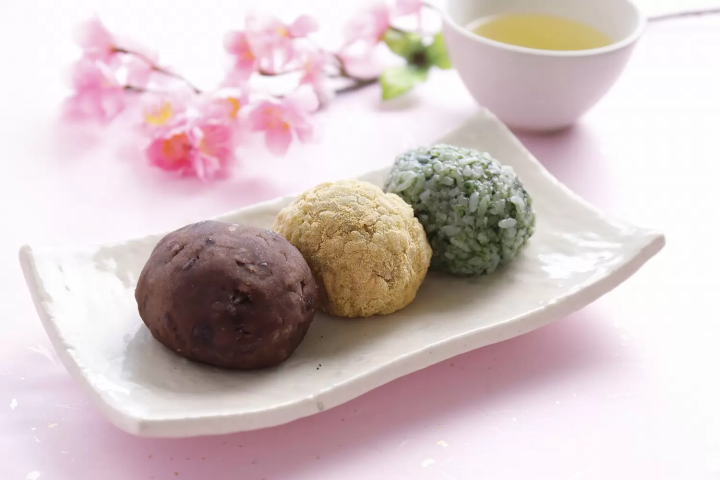
Photo by Pixta
Ohagi is a traditional Japanese sweet made from glutinous rice coated with sweet red bean paste.
During the spring equinox, it is also known as "botamochi," named after the peony flower, and is commonly enjoyed during seasonal transitions.
In some regions, there is a custom of eating ohagi to mark the change of seasons and wish for health and happiness. The standout feature is its chewy texture combined with a delightful sweetness.
A highly recommended place to try ohagi is Sentaro in Kyoto. It is famous for its two varieties: tsubuan (chunky red bean paste) and kinako (roasted soybean flour).
Both are characterized by an elegant sweetness that enhances the ingredients' natural flavors, crafted with exquisite balance. The tsubuan offers a robust bean flavor, while the kinako is distinctly aromatic and nutty.
Founded in 1886, Sentaro is a long-established shop that attracts long lines on holidays due to its popularity.
Sentaro
Address: 576 Nakanocho, Teramachi-dori, Shimogyo-ku, Kyoto City (Main Store)
Business Hours: 8:00 AM - 5:00 PM
Closed: January 1
Official Website: https://www.sentaro.co.jp/ (Japanese)
↑ Return to the top of article.
9. Suama
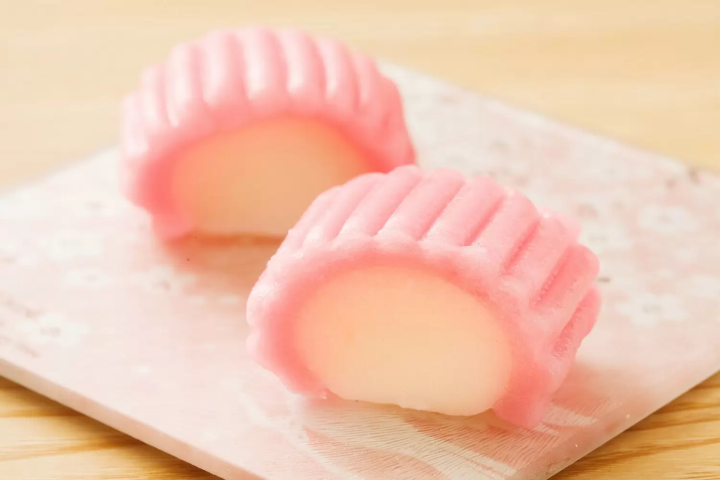
Photo by Pixta
Suama is a traditional Japanese sweet made by kneading flour from glutinous rice with water and sugar, then steaming it.
It is characterized by its soft texture and simple sweetness. Moreover, it is often seen in its natural white color or tinted pink, making it a visually appealing confection.
Particularly popular in the Kanto region, suama is an essential treat for celebrations and seasonal events.
Sakaeya Kashiho in Saitama Prefecture is renowned as a famous suama shop.
Using joshiko (fine flour made from glutinous rice) offers a deep yet simple flavor. Loved by locals for many years, its soft texture and refined sweetness continue to attract many customers.
Sakaeya Kashiho
Address: 1 Kotobuki, Okegawa City, Saitama Prefecture
Business Hours: 9:00 AM - 7:00 PM (until 6:30 PM on Sundays)
Closed: Tuesdays and Wednesdays (except on holidays)
Official Website: https://www.e-sakaeya.net/ (Japanese)
10. Shiruko

Photo by Pixta
Shiruko is a traditional Japanese dessert made by dissolving sweet red bean paste in a liquid. It is usually served with mochi.
This sweet is particularly enjoyed in the colder seasons when the warm dish helps to provide comfort. The soft mochi and sweet bean paste warm both the body and spirit.
A highly recommended place to savor shiruko is Gion Tokuya in Kyoto.
They use high-quality red bean paste made from Tamba's Dainagon azuki beans, known for its elegant sweetness. It is served with freshly grilled mochi, enhancing the overall experience.
Gion Tokuya
Address: 570-127 Gion-cho Minamigawa, Higashiyama-ku, Kyoto City, Kyoto Prefecture
Business Hours: 12:00 PM - 6:00 PM (until sold out)
Closed: Irregular holidays
Official Website: http://gion-tokuya.jp/ (Japanese)
↑ Return to the top of article.
11. Choking Hazard: Precautions When Eating Mochi
When eating mochi confections, please pay attention to the three points below.
Cut into manageable sizes and eat small amounts
Mochi is a sticky and elastic food that can easily choke you.
It is especially important for the elderly and children to cut it into manageable sizes first. This makes it easier to control the amount that goes into the mouth and reduces the risk of choking.
Additionally, eating small amounts allows you to chew thoroughly and mix it with saliva, making it easier to swallow.
Moisten your throat with tea or soup
Keeping your throat moist with tea or soup while eating mochi is important to help prevent choking.
It makes the food slippery and easier to swallow. This method is particularly recommended for the elderly and children, who may have less saliva and weaker swallowing abilities.
However, do not wash it down with tea or soup before chewing well. This can be very dangerous.
Chew thoroughly before swallowing
It is important to chew mochi confections thoroughly before swallowing. Due to its sticky and elastic nature, swallowing without chewing can easily lead to choking.
By chewing well, mochi becomes finer, and mixing it with saliva makes it smoother, allowing it to pass more easily down the throat.
Enjoy Mochi Sweets From All Over Japan
Across Japan, unique mochi-based sweets reflect regional characteristics. While enjoying the differences between Kanto and Kansai styles, why not savor the rich flavors of salted sakura leaves, the freshness of yomogi, and the sweetness of red bean paste?
Visiting famous shops in various regions to experience traditional flavors can also be a delightful adventure!
Read also
Written by Cakutama editorial team
This is the official account of MATCHA's editorial department. Our articles feature useful travel information for visitors to Japan, from how-to guides to recommended places to visit.


































![[ Naruto City, Tokushima Prefecture ] Experience the world's largest whirlpools up close on a sightseeing boat at the Spring Whirlpool Festival!](https://resources.matcha-jp.com/resize/720x2000/2025/02/05-222727.webp)
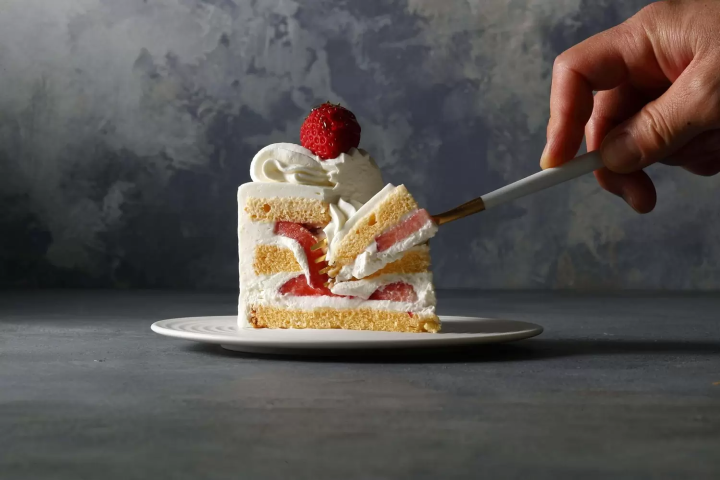
![Deep dive into Japanese brands! A tour of famous leather shoe stores with GENSEI & Nin [Madras Edition]](https://resources.matcha-jp.com/resize/720x2000/2025/12/17-253129.webp)

